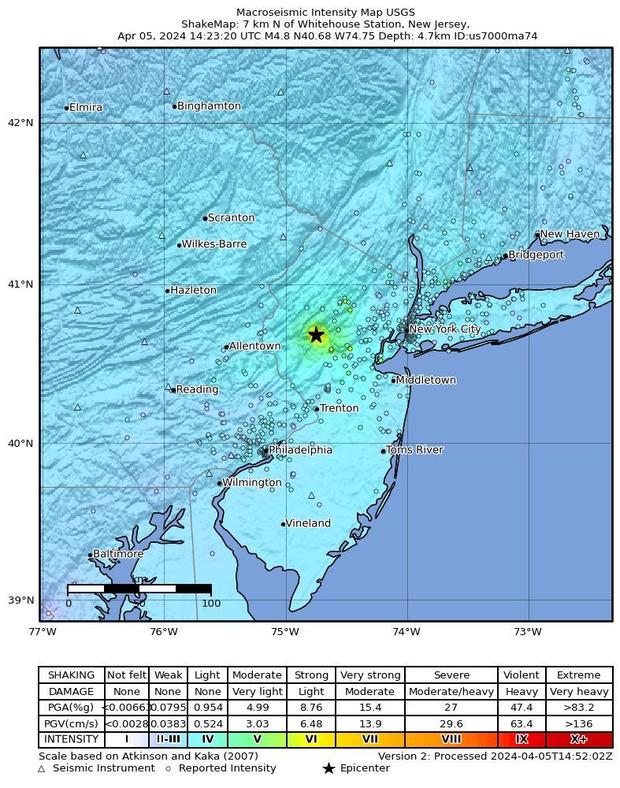How are earthquakes measured? Get the details on magnitude scales and how today's event stacks up
An earthquake rattled much of the Northeast on Friday morning, with shaking felt across the New York City metropolitan area and in communities from Baltimore and Philadelphia up through New England.
The quake had a magnitude of 4.8, according to the U.S. Geological Survey, and it was followed by several aftershocks, including one with a magnitude of 4.0. No major damage was reported as of midday Friday, officials said.
Here's how earthquake strength is measured and what different quake magnitudes mean.
How are earthquakes measured?
Earthquakes are recorded by a network of seismic stations that measure the movement of the ground, according to the USGS. Each station captures data about how much the earth moves and vibrates during a temblor and how much energy moves out from the hypocenter, or the site of an earthquake under the planet's surface.
Multiple scales are used to measure an earthquake. Most commonly, scientists refer to an earthquake's magnitude as a measure of its strength. Geologists once used the Richter scale, but that measure is considered outdated and is no longer used. An earthquake can also be described by its intensity, or the measure of shaking and damage caused by the quake.

What is the magnitude scale of earthquakes?
The magnitude scale is the most common way to measure the size of an earthquake. USGS uses what's caused the moment magnitude scale to measure earthquakes.
"Moment" is a physical quantity proportional to the slip on a fault line multiplied by the area of the fault surface that slipped, USGS said. Moment can be estimated from seismograms and other geological measurements. The moment number is then converted to a scale number, which provides an estimate of the quake's size.
Going up one whole number on the scale indicates the ground motion recorded by seismic equipment increased by a factor of 10. This means a magnitude 5 earthquake would result in about 10 times as much ground movement as a magnitude 4 earthquake, according to the Department of Geological Mining Engineering and Sciences at Michigan Technological University.
The scale has no upper limit, but no fault long enough to generate a magnitude 10 earthquake is known to exist, according to USGS.
In some cases, earthquakes can be so small as to have a negative magnitude, the USGS says.
What is the Richter Scale and why is it outdated?
The Richter Scale is an older method once used for describing the size of earthquakes. The scale was developed by Charles Richter in the 1930s, but USGS says it only worked well on certain frequency and distance ranges. Newer scales were created to account for quakes outside of those ranges.
However, each scale had a limitation, so the moment magnitude scale was developed as a more thorough and uniformly applicable measure for earthquakes.
What is the strongest earthquake ever recorded?
The strongest earthquake ever recorded happened in Chile in 1960. That "megaquake" had a magnitude of 9.5, and occurred on a thousand-mile-long fault line.
That quake lasted for over 11 minutes and triggered tsunamis around the globe. The city of Valdivia was the most affected area, so the quake is sometimes known as the Valdivia Earthquake.
Two million people were left homeless, according to the National Geographic Society. Approximately 1,655 people were killed in the initial quake, and 3,000 people were injured. Higher death tolls include those killed in tsunamis.
The strongest earthquake in U.S. history was the magnitude 9.2 Great Alaska Earthquake of 1964, which also triggered a tsunami.
So, is today's 4.8-magnitude earthquake considered big?
A quake of 2.5 magnitude or less is usually not felt, but can be recorded by a seismograph, according to the Department of Geological Mining Engineering and Sciences at Michigan Technological University.
Quakes that range from 2.5 to 5.4 are felt, but cause only minor damage in most cases. That's the range where this quake in the Northeast falls, and there have been no reports of significant damage or injuries so far. At a magnitude 4.8, it was one of the stronger quakes felt in the area over the past century, but it's not a record. A A 5.0 quake was measured in New York City in 1884, and In 2011, a 5.8 quake centered in Virginia rattled the entire East Coast.
Quakes from 5.5 to 6.0 magnitude can cause some damage.
Quakes that range from 6.1 to 6.9 magnitude can cause "a lot of damage in very populated areas," while a 7.0 to 7.9 magnitude earthquake is considered a major earthquake causing serious damage. Next is an 8.0 or greater magnitude, which is considered a massive quake that can "totally destroy communities" near its epicenter.
No tsunami activity is expected because of today's earthquake, and aftershock possibility remains low, officials said.
- In:
- Chile
- New Jersey
- East Coast
- Earthquakes
- Earthquake
- New York

Kerry Breen is a reporter and news editor at CBSNews.com. A graduate of New York University's Arthur L. Carter School of Journalism, she previously worked at NBC News' TODAY Digital. She covers current events, breaking news and issues including substance use.
TwitterDisclaimer: The copyright of this article belongs to the original author. Reposting this article is solely for the purpose of information dissemination and does not constitute any investment advice. If there is any infringement, please contact us immediately. We will make corrections or deletions as necessary. Thank you.






